Complete List to Watch the Harry Potter Movies in Chronological Order
The grand finale of the Harry Potter movies saga comes in two parts, both titled Harry Potter and the Deathly Hallows, released in 2010 and 2011, respectively.
Here’s a summarized conclusion of the movie series in order:
Part 1:
- Harry, Ron, and Hermione hunt for Horcruxes, fragments of Voldemort’s soul that must be destroyed.
- They face isolation, mistrust, and internal conflict while navigating a world shrouded in fear and danger.
- Significant losses and sacrifices mark their journey, testing their resolve and highlighting the cost of freedom.
- The film ends with Harry facing Voldemort in a tense showdown, only to be saved by an unforeseen twist.
Part 2:
- The Battle of Hogwarts erupts, unleashing a spectacular magic duel between good and evil.
- Beloved characters fall in the fight, adding weight and emotional depth to the conflict.
- Harry uses his connection to loved ones and discovered Horcruxes to finally confront Voldemort.
- An epic final battle ensues, culminating in Voldemort’s defeat and the restoration of peace to the wizarding world.
- The film concludes with Harry and his friends picking up the pieces, mourning their losses, and celebrating their hard-won victory.
The Deathly Hallows films showcase the culmination of Harry’s journey from a curious schoolboy to a courageous hero. They explore themes of love, loss, sacrifice, good versus evil, and the importance of friendship and hope in the face of overwhelming darkness. The series ends with a bittersweet resolution, leaving a lasting impression on viewers and cementing its place as a beloved cinematic and literary treasure.
Harry Potter Movies in Chronological Order
While the Harry Potter movies were released in order of publication of the books (with the exception of the Deathly Hallows being split into two parts), there’s a separate chronological order that follows the actual timeline of events within the story. Here’s the list of Harry Potter movies in chronological order:
1. Fantastic Beasts and Where to Find Them (2016)
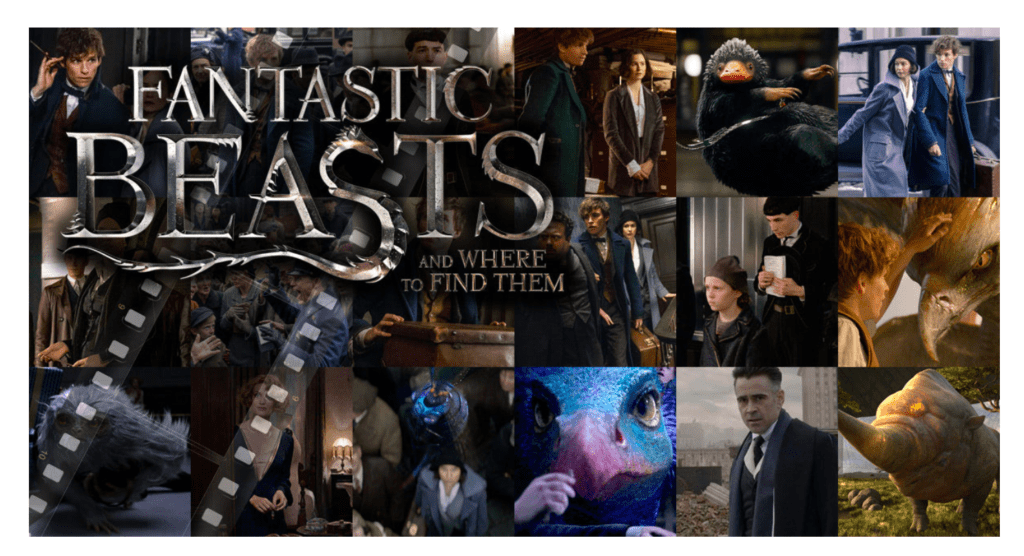
“Fantastic Beasts and Where to Find Them” (2016) isn’t just a movie; it’s a portal back into the enchanting world of J.K. Rowling’s wizarding universe, this time set seven decades before Harry Potter’s adventures. We’re whisked away to 1926 New York City, where magizoologist Newt Scamander, played with endearing awkwardness by Eddie Redmayne, arrives with a suitcase brimming with curious creatures. But a case mishap and a No-Maj named Jacob (the delightful Dan Fogler) unleash chaos, forcing Newt to track down his escaped beasts before they expose the wizarding community.
The film is a delightful feast for the senses. Director David Yates masterfully captures the bustling cityscape, imbuing it with a layer of magical secrecy. We encounter whimsical alleyways hidden behind speakeasies, a clandestine wizarding society disguised within plain sight, and of course, Newt’s magical menagerie, a menagerie teeming with wonder. From the mischievous Niffler, obsessed with shiny things, to the majestic Thunderbird, soaring across the Brooklyn Bridge, each creature is meticulously crafted and imbued with its own unique personality.
But beyond the fantastical creatures, the film’s heart lies in its characters. Newt is an endearing misfit, passionate about his beasts yet socially awkward. His journey becomes one of self-discovery, as he grapples with prejudice and learns to trust others. Jacob’s wide-eyed wonder at the magical world provides a relatable entry point for the audience, while characters like Tina Goldstein (Katherine Waterston) and Queenie Goldstein (Alison Sudol) add layers of complexity and wit.
The film’s themes resonated deeply with audiences. The fear of exposure and the clash between magical and non-magical communities mirrored real-world struggles with discrimination and intolerance. Yet, “Fantastic Beasts” also offers a message of hope. Through Newt’s compassion and the unlikely bond between wizards and No-Majs, the film highlights the importance of understanding and acceptance.
“Fantastic Beasts” is more than just a prequel; it’s a captivating expansion of the Wizarding World, introducing us to a new era of magic and captivating characters. It’s a film that celebrates the power of imagination, the beauty of diversity, and the enduring magic of believing in something wonderful.
Here are some additional points you might find interesting to include:
- The film’s score by James Newton Howard beautifully complements the visuals and emotions.
- The introduction of Credence Barebone (Ezra Miller) hints at a darker storyline that unfolds in later films.
- The film’s visual effects are stunning, bringing the creatures and magical world to life with breathtaking detail.
Whether you’re a die-hard Potterhead or a newcomer to the magical world, “Fantastic Beasts and Where to Find Them” is a film that promises a captivating escape and leaves you yearning for more adventures in this enchanting realm.
2. Fantastic Beasts: The Crimes of Grindelwald (2018)
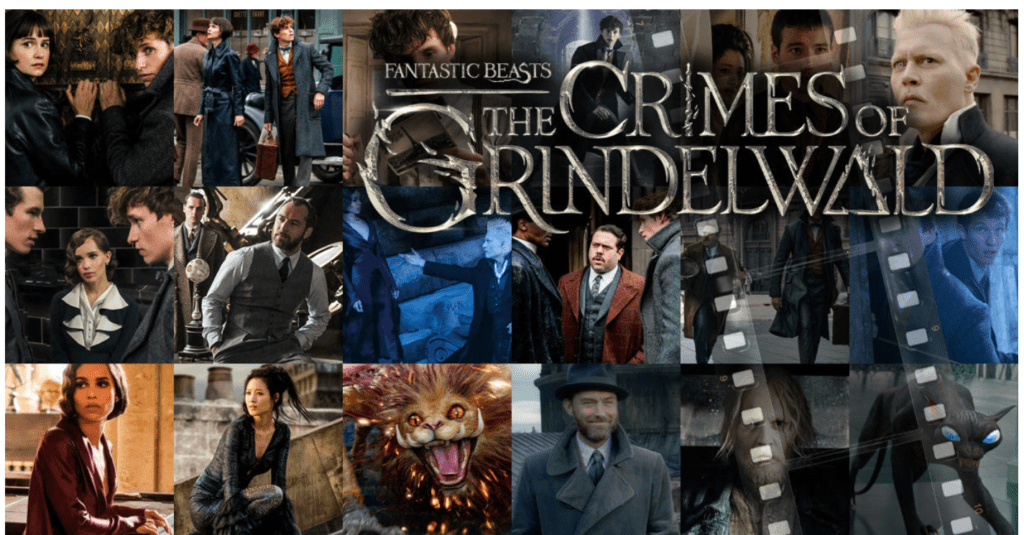
“Fantastic Beasts: The Crimes of Grindelwald” (2018) marks a dramatic shift in the Wizarding World. Stepping away from the whimsical charm of Newt Scamander’s creature adventures, the film plunges us into a world teetering on the brink of war. Darker, more complex, and riddled with secrets, it takes audiences on a thrilling but controversial journey.
The film reunites us with Newt (Eddie Redmayne), still the endearingly awkward magizoologist, though now enlisted by his former teacher, Albus Dumbledore (Jude Law), to thwart the rising power of Gellert Grindelwald (Johnny Depp). Grindelwald, a charismatic yet dangerous wizard, advocates for pure-blood wizard supremacy, inciting fear and discord across the magical world. This sets the stage for a tense political climate, where old allegiances are tested and new alliances forged.
Gone are the lighthearted escapades of the first film. “The Crimes of Grindelwald” is a web of intrigue and deception, with characters navigating complex personal conflicts and hidden agendas. The film delves deeper into the history of the Wizarding World, exploring Dumbledore’s troubled past and introducing secrets that bind him to Grindelwald. This complex dynamic, rife with unspoken emotions and unspoken promises, sets the stage for a heartbreaking confrontation.
However, the film’s ambitious scope comes at a cost. With a sprawling cast and multiple plotlines, the narrative can feel convoluted at times. Characters like Queenie Goldstein (Alison Sudol) and Leta Lestrange (Zoë Kravitz) suffer from underdeveloped arcs, leaving their motivations and actions murky. While visually stunning, the action sequences occasionally overshadow the emotional core of the story.
Despite its flaws, “The Crimes of Grindelwald” offers a compelling glimpse into the darkest corners of the Wizarding World. It tackles themes of prejudice, manipulation, and the seductive power of populism, themes that resonate even today. The film’s climax, a stunning display of magical prowess, leaves audiences with a sense of awe and foreboding for the coming conflict.
Ultimately, “The Crimes of Grindelwald” is a film that demands engagement. It rewards attentive viewers with hidden clues, clever callbacks, and moments of profound emotional resonance. While it may not recapture the lighthearted magic of its predecessor, it paves the way for a darker, more mature chapter in the Fantastic Beasts saga. Whether you embrace its complexities or find it frustratingly opaque, one thing is certain: “The Crimes of Grindelwald” casts a long shadow that will continue to shape the future of the Wizarding World.
Here are some additional points you might want to consider:
- The film’s visual effects are even more impressive than the first film, particularly in the final battle sequence.
- The introduction of Nicholas Flamel (Brontis Jodorowsky) and Nagini (Claudia Kim) hints at future connections to the Harry Potter series.
- The film’s reception was divisive, with some praising its ambition and others criticizing its convoluted plot and underdeveloped characters.
Ultimately, whether you view “The Crimes of Grindelwald” as a triumph or a stumble, it stands as a testament to the enduring power of J.K. Rowling’s magical universe and its ability to spark discussion and debate long after the credits roll.
3. Fantastic Beasts: The Secrets of Dumbledore (2022)
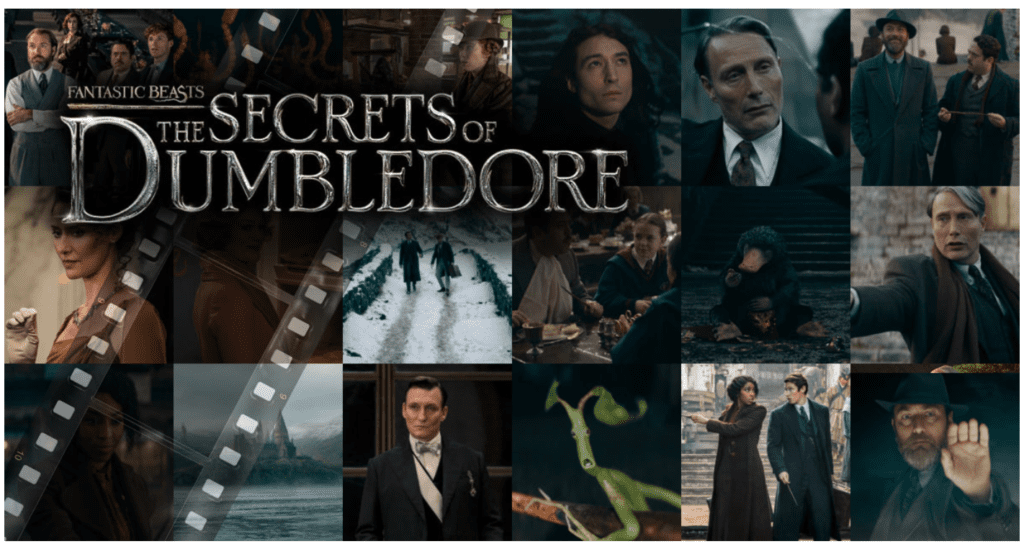
“Fantastic Beasts: The Secrets of Dumbledore” (2022) marks the third chapter in the “Fantastic Beasts” spin-off series, taking us deeper into the magical world decades before Harry Potter’s adventures. This time, the stakes are higher than ever as the charismatic dark wizard Gellert Grindelwald (Mads Mikkelsen, taking over Johnny Depp’s portrayal) rises to power, aiming to subjugate non-magical beings (No-Majs) and rule the wizarding world.
Enter Albus Dumbledore (Jude Law), a young yet powerful wizard burdened by a complex past and a blood pact with Grindelwald that prevents him from directly confronting his former friend. To thwart Grindelwald’s plans, Dumbledore assembles a ragtag team of allies, including his ever-reliable magizoologist friend Newt Scamander (Eddie Redmayne), the enigmatic auror Tina Goldstein (Katherine Waterston), and the charming baker Jacob Kowalski (Dan Fogler).
Director David Yates returns to helm the film, infusing it with the familiar Wizarding World charm while taking it into darker territory. The secrets of Dumbledore’s past unfold gradually, revealing a heartbreaking connection to Grindelwald and a burden that shapes his motivations throughout the film. Jude Law delivers a nuanced performance, capturing both Dumbledore’s youthful brilliance and the weight of his unspoken past.
Mikkelsen brings a chilling intensity to Grindelwald, transforming him from a cunning manipulator into a full-blown tyrant. His fiery speeches and unwavering belief in his twisted ideology create a palpable sense of danger and urgency throughout the film.
The supporting cast shines as well, with Redmayne’s endearing awkwardness as Newt providing some much-needed comic relief, and Waterston and Fogler bringing depth and emotional resonance to their roles. The film also introduces new characters such as Bunty Broadacre (Jessica Williams), a talented witch with a knack for disguise, and Yusuf Kama (Callum Turner), a mysterious Auror with his own hidden agenda.
Beyond the compelling characters and intricate plot, “The Secrets of Dumbledore” boasts stunning visuals and breathtaking magical creatures. From the majestic Qilin, a creature said to embody purity and choose the next leader of the wizarding world, to the mischievous Niffler, Newt’s ever-present furry companion, the film is a feast for the eyes.
However, the film isn’t without its flaws. The pacing can feel uneven at times, and the convoluted plot with multiple layers of secrets and hidden agendas can be challenging to follow. Additionally, some character arcs, particularly those of Queenie Goldstein (Alison Sudol) and Credence Barebone (Ezra Miller), feel underdeveloped, leaving some emotional threads unsatisfied.
Despite these minor shortcomings, “Fantastic Beasts: The Secrets of Dumbledore” delivers a thrilling and emotionally charged chapter in the Wizarding World saga. It explores complex themes of loyalty, sacrifice, and the fight against tyranny, all woven into a captivating narrative filled with familiar magic and captivating new characters.
Whether you’re a die-hard Potterhead or a newcomer to the magical world, “The Secrets of Dumbledore” is a film that promises a mesmerizing escape and leaves you yearning for more adventures in this ever-expanding universe.
Here are some additional points you might find interesting to include:
- The film incorporates more explicit references to Dumbledore’s sexuality, hinting at his relationship with Grindelwald.
- The Qilin plays a pivotal role in the film’s climax, setting the stage for future conflicts within the wizarding world.
- The film’s visual effects are even more impressive than previous installments, particularly in the magical creature sequences.
Ultimately, “Fantastic Beasts: The Secrets of Dumbledore” is a film that invites discussion and interpretation. It delves deeper into the lore of the Wizarding World while exploring mature themes and showcasing both the beauty and darkness that exist within magical society. It’s a film that leaves you pondering the choices we make, the secrets we keep, and the lengths we’ll go to for those we love.
4. A Magical Beginning: Revisiting the Enchantment of Harry Potter and the Sorcerer’s Stone (2001)

For an entire generation, the year 2001 wasn’t just marked by the turn of the millennium, but by the arrival of a bespectacled boy named Harry Potter. “Harry Potter and the Sorcerer’s Stone” (also known as “The Philosopher’s Stone” in some countries) wasn’t just a movie; it was a cultural phenomenon, igniting a global obsession with the enchanting world of Hogwarts School of Witchcraft and Wizardry.
More than two decades later, the film’s magic remains undimmed. Stepping back into this world is like revisiting a beloved childhood friend, each scene evoking a rush of nostalgia and wonder. We meet Harry, an orphaned boy living a miserable life with his neglectful aunt, uncle, and cousin. On his eleventh birthday, however, his world is turned upside down when he learns he’s a wizard and is whisked away to Hogwarts, a hidden school for magic.
Hogwarts is the beating heart of the film, a fantastical castle brimming with secret passageways, talking portraits, and mischievous ghosts. Director Chris Columbus brings J.K. Rowling’s vivid descriptions to life with meticulous detail, from the grand Great Hall to the cozy Gryffindor common room. Each nook and cranny breathes magic, inviting us to believe that somewhere within those ancient walls, anything is possible.
But Hogwarts isn’t just about spells and potions. It’s about friendship, loyalty, and courage. Harry finds a home amidst his fellow Gryffindors, the brave and loyal Ron Weasley and the brilliant and resourceful Hermione Granger. Together, they navigate the labyrinthine corridors of the castle, encounter quirky professors like the wise Dumbledore and the stern Snape, and face challenges that test their mettle.
The film’s central conflict revolves around the Sorcerer’s Stone, a powerful artifact that grants immortality. The evil Lord Voldemort, who seeks to return to power after his near-death encounter with Harry’s parents, is also after the stone. This sets the stage for a thrilling adventure, culminating in a showdown that tests Harry’s newfound skills and forces him to confront his own destiny.
“Harry Potter and the Sorcerer’s Stone” is a film that transcends age and genre. It’s a timeless coming-of-age story that resonates with anyone who has ever felt like an outsider. It’s a celebration of imagination, reminding us that magic can be found not just in spells and potions, but in the bonds of friendship, the power of love, and the courage to stand up for what’s right.
Even after all these years, the film’s spellbinding charm remains potent. We’re still captivated by the wonder of Hogwarts, the thrill of Quidditch matches, and the heartwarming friendships at the heart of the story. “Harry Potter and the Sorcerer’s Stone” is more than just a movie; it’s an invitation to step into a world of endless possibilities, where anything is possible if you just believe.
So, if you’re looking for a dose of magic, a reminder of the power of friendship, and a journey that will stay with you long after the credits roll, revisit “Harry Potter and the Sorcerer’s Stone.” It’s a timeless classic that never loses its ability to enchant and inspire.
Here are some additional points you might find interesting to include:
- The film’s score by John Williams is instantly recognizable and iconic, perfectly capturing the wonder and excitement of the wizarding world.
- The casting of the film is perfect, with Daniel Radcliffe, Rupert Grint, and Emma Watson capturing the essence of Harry, Ron, and Hermione with remarkable accuracy.
- The film’s special effects, while not as advanced as today’s standards, still hold up remarkably well and contribute to the film’s immersive atmosphere.
- “Harry Potter and the Sorcerer’s Stone” sparked a global phenomenon, with subsequent films, books, theme parks, and merchandise captivating audiences for generations.
Ultimately, “Harry Potter and the Sorcerer’s Stone” is a film that reminds us that the magic never truly fades. It’s a story that continues to inspire, entertain, and ignite imaginations, proving that sometimes, all it takes is a little bit of faith to believe in the impossible.
5. Delving into the Darker Depths: Exploring the Enigmas of “Harry Potter and the Chamber of Secrets” (2002)
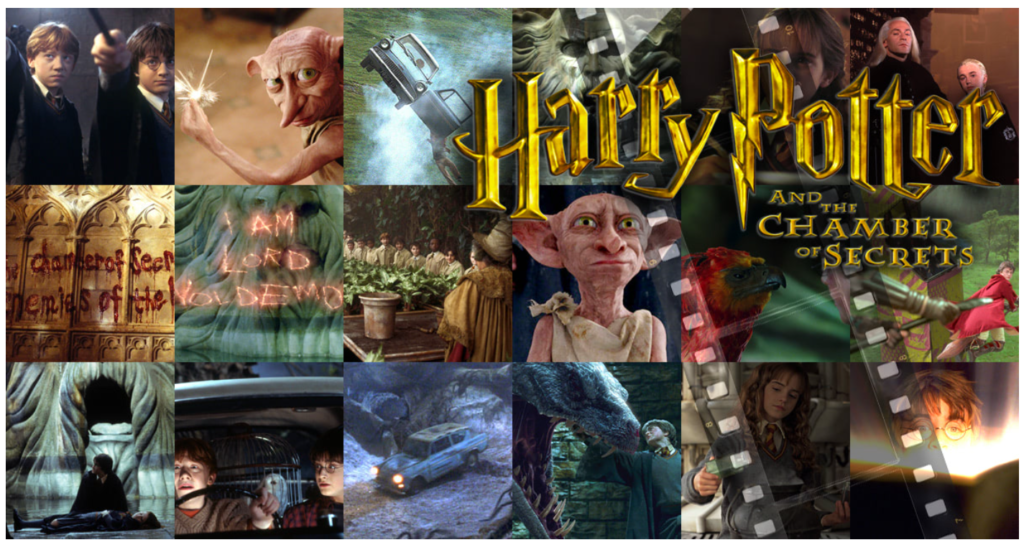
While “Harry Potter and the Sorcerer’s Stone” introduced us to the magical world of Hogwarts, “Harry Potter and the Chamber of Secrets” (2002) ventured deeper, delving into darker mysteries and unveiling hidden secrets. The film takes us back to Harry’s second year at Hogwarts, where whispers of a sinister past and petrifying attacks plague the corridors of the ancient castle.
Gone are the lighthearted whimsy and wide-eyed wonder of the first film. “Chamber of Secrets” casts a darker shadow, exploring themes of prejudice, fear, and the legacy of evil. We see Hogwarts under suspicion, secrets bubbling beneath the surface, and even Harry, our valiant hero, grappling with self-doubt and a hidden connection to the darkness unfolding.
The film introduces us to unforgettable characters like Dobby, the mischievous house-elf who warns Harry of danger, and Gilderoy Lockhart, the flamboyant Defense Against the Dark Arts professor whose facade hides a sinister truth. We also encounter Tom Riddle, a charming young man with a hidden past and a chilling connection to the Chamber of Secrets itself.
The mystery deepens as petrified students are discovered, one by one, frozen by a mysterious basilisk said to reside within the Chamber. Harry, along with his loyal friends Ron Weasley and Hermione Granger, investigates the attacks, deciphering cryptic clues and facing perilous challenges. Their journey takes them through hidden passageways, into forbidden forests, and ultimately, into the depths of the Chamber itself.
“Chamber of Secrets” is more than just a thrilling adventure; it’s a coming-of-age story. Harry confronts his fears, discovers his hidden strengths, and learns the true meaning of courage and friendship. He faces prejudice and discrimination, both from others and from within himself, ultimately recognizing the dangers of intolerance and the importance of accepting differences.
The film’s visual effects are stunning, bringing the fantastical creatures and magical world of Hogwarts to life with breathtaking detail. From the majestic phoenix Fawkes to the terrifying basilisk, each creature is meticulously crafted and adds to the film’s immersive atmosphere.
“Harry Potter and the Chamber of Secrets” might not have the wide-eyed wonder of its predecessor, but it delves deeper into the complexities of the wizarding world and its characters. It explores darker themes without losing its sense of adventure and magic, making it a worthy successor to the first film and a captivating chapter in the beloved Harry Potter saga.
Here are some additional points you might find interesting to include:
- The film’s score by John Williams continues to be iconic, with new themes introduced to reflect the darker atmosphere.
- The casting remains impeccable, with Daniel Radcliffe, Rupert Grint, and Emma Watson further establishing themselves as the perfect trio of Harry, Ron, and Hermione.
- The film introduces key elements of the series’ overarching plot, including the history of Tom Riddle and the existence of Horcruxes.
- “Chamber of Secrets” marks the debut of several beloved characters, including Professor McGonagall, Ginny Weasley, and Luna Lovegood.
Ultimately, “Harry Potter and the Chamber of Secrets” is a film that rewards repeat viewings. With its intricate plot, unforgettable characters, and themes that resonate across ages, it continues to captivate audiences and holds a special place in the hearts of Potterheads everywhere.
So, grab your wand, put on your Sorting Hat, and prepare to journey back into the Chamber of Secrets. The mystery and magic await!
6. A Turning Point in Magic: Delving into the Chilling Charm of “Harry Potter and the Prisoner of Azkaban” (2004)

“Harry Potter and the Prisoner of Azkaban” (2004) marks a pivotal turning point in the beloved saga. Gone are the whimsical charm of the first two films, replaced by a brooding atmosphere, complex themes, and a darker edge that reflects Harry’s journey into adolescence and the growing threat posed by the infamous Lord Voldemort.
Director Alfonso Cuarón brings a fresh, cinematic vision to the series, infusing the narrative with a dreamlike quality and masterful use of light and shadow. Hogwarts transforms from a welcoming haven into a looming castle shrouded in mystery, as the escaped convict Sirius Black, Harry’s godfather, casts a long and menacing shadow over his third year.
The film delves deeper into Harry’s emotional core, exploring themes of loss, grief, and the search for identity. We see him grapple with the complexities of family, confronting the secrets surrounding his parents’ death and forging an unexpected bond with his enigmatic godfather. The introduction of Professor Lupin, the gentle Defense Against the Dark Arts teacher, and the enigmatic time-turner offer both solace and peril, reminding us that time is both a powerful tool and a fleeting treasure.
“Prisoner of Azkaban” isn’t just about dark corridors and whispered fears; it’s a celebration of loyalty and friendship. Harry, Ron, and Hermione’s bond is tested throughout, but their unwavering support for each other becomes their strongest weapon against adversity. The film introduces Luna Lovegood, the whimsical and eccentric seer, whose quirky charm and unwavering belief in Harry serve as a beacon of hope in the face of darkness.
The special effects, while not as polished as later installments, still hold up remarkably well. From the chilling Dementors, soul-sucking creatures that drain happiness, to the breathtaking hippogriff Buckbeak’s flight, the film is a visual feast that continues to impress even after nearly two decades.
“Harry Potter and the Prisoner of Azkaban” is more than just a film; it’s a transformative experience. It marks a shift in tone and maturity for the series, paving the way for the darker chapters to come. It’s a film that lingers long after the credits roll, forcing us to confront our own fears, celebrate the power of friendship, and cherish the fleeting moments of joy in the face of darkness.
Here are some additional points you might find interesting to include:
- The film’s score by Michael Giacchino is hauntingly beautiful, perfectly capturing the film’s melancholic and suspenseful atmosphere.
- The casting remains strong, with Gary Oldman delivering a captivating performance as Sirius Black.
- The film explores more mature themes, including prejudice, identity, and the nature of good and evil.
- “Prisoner of Azkaban” is often considered one of the best films in the Harry Potter series, garnering critical acclaim for its direction, performances, and visual effects.
Ultimately, “Harry Potter and the Prisoner of Azkaban” is a film that reminds us that even in the darkest of times, hope and friendship can prevail. It’s a testament to the magic of storytelling, and a reminder that growing up doesn’t always mean losing the sense of wonder that makes the world around us so enchanting.
So, grab your wand, summon your Patronus, and prepare to step into the shadows. The chilling charm of “Harry Potter and the Prisoner of Azkaban” awaits you.
| Do You Know? 12 different publishing houses rejected the Harry Potter series before Bloomsbury Publishing House UK finally published it. |
7. Stepping into the Flames: Revisiting the Excitement and Euphoria of “Harry Potter and the Goblet of Fire” (2005)
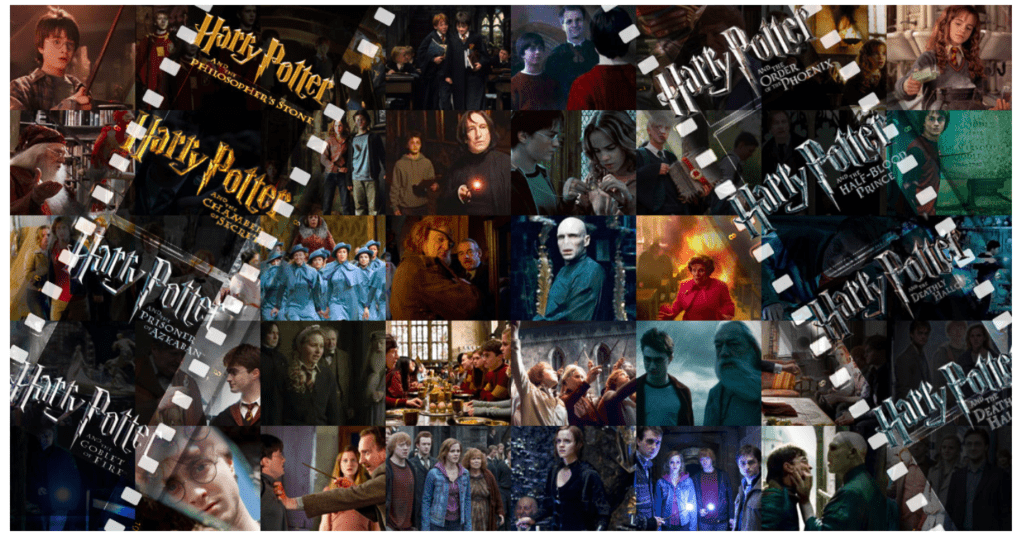
“Harry Potter and the Goblet of Fire” (2005) marks a fiery turning point in the beloved saga. Gone are the cozy comforts of Hogwarts and the whimsical charm of childhood adventures. Stepping into the fourth year, we find ourselves amidst a whirlwind of international magic, perilous challenges, and a growing darkness that threatens to engulf the wizarding world.
Director Mike Newell takes the reins from Alfonso Cuarón, injecting the film with a thrilling pace and an energy that mirrors the Triwizard Tournament, the central event that sets the narrative ablaze. Hogwarts welcomes delegations from two other prestigious magical schools, Beauxbatons and Durmstrang, creating a vibrant spectacle of cultural exchange and fierce competition. But amidst the revelry, a sinister plot unfolds, fueled by the malevolent whispers of Lord Voldemort’s return.
Harry, once again thrust into the center of chaos, finds himself unexpectedly chosen as a fourth champion in the tournament. Each task pushes him to his limits, testing his courage, resourcefulness, and magical prowess. From battling a monstrous Hungarian Horntail to navigating a treacherous underwater maze, Harry’s journey becomes a captivating spectacle, keeping us on the edge of our seats.
But “Goblet of Fire” is much more than just a dazzling display of magical feats. It’s a profound exploration of adolescence, loss, and the complexities of human relationships. We see Harry grapple with the burden of expectations, the sting of betrayal, and the agony of witnessing the first true deaths within his world. The film isn’t afraid to delve into these darker themes, adding depth and emotional resonance to the narrative.
The supporting cast shines brighter than ever, offering moments of comedic relief and unwavering support. Ron’s insecurities and Hermione’s fierce loyalty provide humor and heart, while characters like Professor Moody and Neville Longbottom add layers of intrigue and unexpected heroism.
The film’s visuals are a feast for the eyes. From the majestic Quidditch World Cup to the breathtaking underwater sequence, “Goblet of Fire” transports us into a world brimming with fantastical creatures and breathtaking landscapes. The special effects, particularly the portrayal of the dragons and the Grindylows, remain impressive even today.
However, “Goblet of Fire” isn’t without its flaws. The film’s rapid pace can sometimes feel rushed, leaving certain character arcs underdeveloped. Additionally, the emotional impact of Cedric Diggory’s death, while undeniably powerful, could have benefited from more screen time dedicated to the aftermath.
Despite these minor shortcomings, “Harry Potter and the Goblet of Fire” remains a thrilling and exhilarating chapter in the series. It’s a film that celebrates friendship, courage, and the power of facing our fears, even when the flames of danger lick at our heels. It’s a testament to the enduring magic of J.K. Rowling’s world, leaving us yearning for more adventures as we step out of the flames and into the ever-darkening shadows of the coming battles.
So, grab your wands, don your Gryffindor scarves, and prepare to be swept away by the fiery magic of “Harry Potter and the Goblet of Fire.” The Triwizard Tournament awaits, and the fate of the wizarding world hangs in the balance.
Here are some additional points you might find interesting to include:
- The film’s score by Patrick Doyle is both thrilling and evocative, capturing the excitement of the tournament and the underlying darkness that threatens to engulf the story.
- The casting remains impeccable, with Daniel Radcliffe, Rupert Grint, and Emma Watson delivering their most mature performances yet.
- “Goblet of Fire” introduces several important characters, including Barty Crouch Jr., Alastor Moody (disguised), and Nymphadora Tonks, who will play key roles in future installments.
- The film marks the beginning of a darker tone for the series, preparing audiences for the challenges and sacrifices that lie ahead.
Ultimately, “Harry Potter and the Goblet of Fire” is a film that ignites both excitement and reflection. It’s a thrilling ride through a world of magic and danger, but it also compels us to confront the harsh realities of loss, betrayal, and the ever-present struggle between good and evil. It’s a film that stays with you long after the credits roll, leaving you yearning for more adventures and forever grateful for the power of magic to transport us to a world where anything is possible.
8. Facing the Darkness Within: Exploring the Shadowy Depths of “Harry Potter and the Order of the Phoenix” (2007)
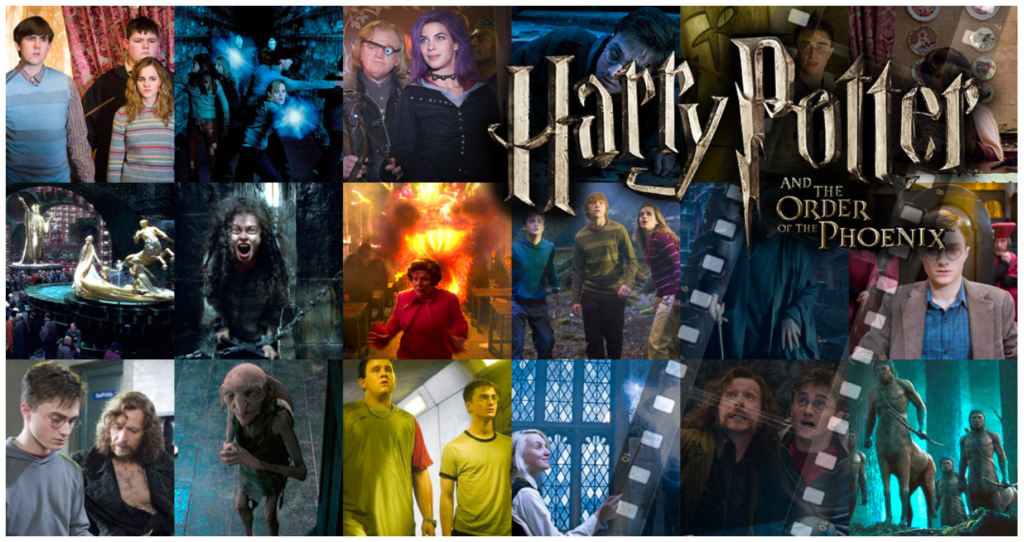
“Harry Potter and the Order of the Phoenix” (2007) marks a stark turning point in the beloved saga. Gone are the whimsical charm of childhood adventures and the thrill of sporting events. Stepping into the fifth year, we find ourselves plunged into a world shrouded in denial, suspicion, and a growing darkness that threatens to consume both Harry and the wizarding world.
Director David Yates takes the helm, infusing the film with a gritty realism and a brooding atmosphere that reflects the escalating conflict. Hogwarts, once a sanctuary of warmth and wonder, becomes a battleground for misinformation and dissent, as the Ministry of Magic refuses to acknowledge the return of Lord Voldemort. This sets the stage for a narrative rife with emotional turmoil, political intrigue, and the agonizing consequences of inaction.
Harry, burdened by the weight of his unwanted celebrity and ostracized by the very world he’s sworn to protect, grapples with isolation, anger, and a gnawing sense of powerlessness. The film delves into the complexities of trauma, showcasing the profound impact of witnessing Cedric Diggory’s death in the previous film. Daniel Radcliffe delivers a captivating performance, capturing Harry’s vulnerability and his desperate need to take control in the face of mounting chaos.
But “Order of the Phoenix” is not just about Harry’s inner struggles. It’s a testament to the enduring power of friendship and resistance. We see the formation of the titular Order, a clandestine group of dedicated individuals led by the wise, yet aging, Albus Dumbledore, who stands firmly against the Ministry’s denial. Characters like Sirius Black, Remus Lupin, and Tonks offer unwavering support and guidance, reminding us that even in the darkest of times, we are never truly alone.
The film delves deeper into the lore of the wizarding world, introducing the Room of Requirement, a magical space that adapts to the needs of those who find it, and the Department of Mysteries, a hidden labyrinth within the Ministry containing powerful artifacts and forgotten secrets. These elements not only expand the narrative universe but also serve as metaphors for the hidden truths and emotional depths that lie within each of us.
However, “Order of the Phoenix” is not without its flaws. The film’s sprawling cast and intricate plot can sometimes feel overwhelming, leaving some character arcs underdeveloped. Additionally, the climactic battle, while visually stunning, feels somewhat rushed compared to the emotional build-up throughout the film.
Despite these shortcomings, “Harry Potter and the Order of the Phoenix” remains a powerful and poignant chapter in the series. It reminds us that facing our fears and challenging the status quo are essential ingredients in the fight against oppression and injustice. It’s a film that compels us to confront the darkness within ourselves and embrace the power of collective action in the face of overwhelming odds.
So, grab your wands, don your Order of the Phoenix robes, and prepare to delve into the shadowy depths of “Harry Potter and the Order of the Phoenix.” The fight for truth and justice has just begun.
Here are some additional points you might find interesting to include:
- The film’s score by Nicholas Hooper is haunting and evocative, perfectly capturing the film’s dark atmosphere and moments of quiet reflection.
- The casting remains strong, with Evanna Lynch delivering a breakout performance as Luna Lovegood.
- “Order of the Phoenix” marks the death of Sirius Black, a pivotal moment in the series that leaves a lasting emotional impact.
- The film explores themes of teenage rebellion, political corruption, and the importance of speaking truth to power.
Ultimately, “Harry Potter and the Order of the Phoenix” is a film that demands engagement and introspection. It challenges us to confront uncomfortable truths, fight for what we believe in, and find solace in the unwavering strength of friendship and courage. It’s a film that stays with you long after the credits roll, leaving you forever changed by its exploration of the darkness within and the unwavering light that guides us through it.
9. A Waltz with Shadows: Unmasking the Romance and Darkness of “Harry Potter and the Half-Blood Prince” (2009)
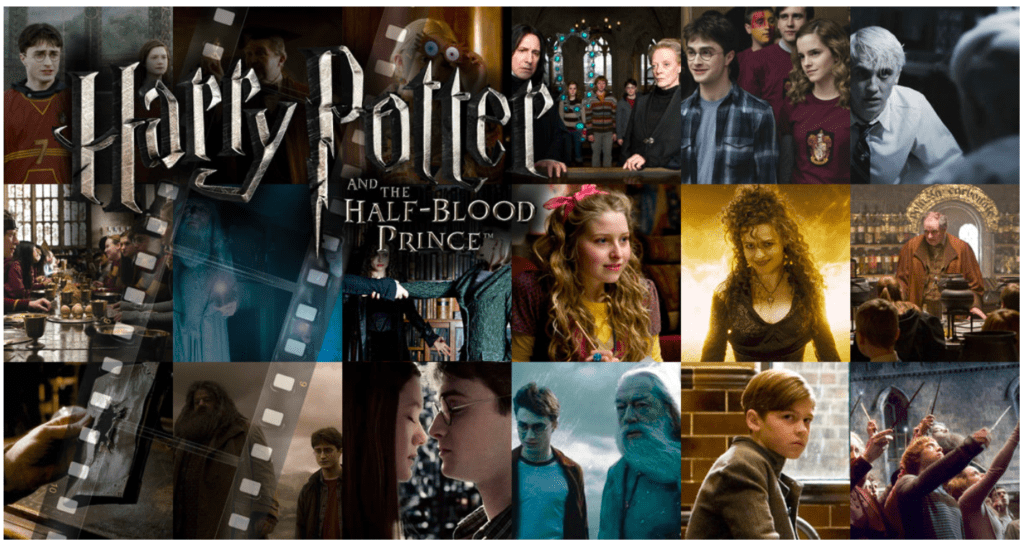
“Harry Potter and the Half-Blood Prince” (2009) marks a bittersweet waltz between love’s burgeoning bloom and the encroaching shadows of war. Gone are the youthful angst and fiery battles of previous chapters. Stepping into the sixth year, we find ourselves amidst a Hogwarts draped in teenage romance, simmering anxieties, and the chilling whispers of Voldemort’s growing power.
Director David Yates returns, further refining his gritty realism and infusing the narrative with a melancholic beauty that reflects the film’s complex emotional tapestry. Hogwarts transforms into a stage for adolescent desires, blossoming romances, and unspoken fears. Harry, grappling with loss and the burden of prophecy, finds solace in the intoxicating aroma of Amortentia and the awkward yet endearing courtship of his longtime friend Ginny Weasley. Daniel Radcliffe delivers a nuanced performance, capturing Harry’s vulnerable moments alongside his unwavering determination.
But love’s melody is soon drowned out by the ominous drumbeat of war. Lord Voldemort’s presence becomes a palpable threat, infiltrating Hogwarts through Draco Malfoy, a conflicted young man burdened by both fear and familial loyalty. The film delves into the complexities of morality, showcasing the allure of the Dark Arts and the seductive power of peer pressure. Tom Felton shines as Draco, portraying his internal struggles with remarkable depth and empathy.
At the heart of the narrative lies a mystery shrouded in potions. A well-worn textbook titled “Half-Blood Prince” containing cryptic annotations unlocks a hidden world of magical prowess and unexpected connections. The film celebrates the art of deduction and the thrill of discovery, reminding us that knowledge and resourcefulness can be powerful weapons against even the darkest forces.
“Half-Blood Prince” is not merely a coming-of-age story; it’s a poignant reflection on loss and sacrifice. Dumbledore’s journey through memories, facilitated by the pensive, reveals his regrets and vulnerabilities, adding layers of humanity to the seemingly invincible wizard. The death of a beloved character leaves a lasting emotional scar, reminding us that even in the face of magic, some losses are permanent and the cost of freedom can be high.
However, the film isn’t solely consumed by darkness. Moments of humor and camaraderie provide flashes of light, reminding us that hope and laughter can persist even in the face of uncertainty. The Weasley twins’ mischievous antics and Luna Lovegood’s eccentric charm offer welcome levity, while the enduring bond between Harry and his friends underscores the importance of human connection in the fight against evil.
Despite its emotional complexity, “Half-Blood Prince” suffers from minor pacing issues, with certain subplots feeling underdeveloped. Additionally, the final confrontation, while visually stunning, lacks the emotional weight of other climactic battles in the series.
Nevertheless, “Harry Potter and the Half-Blood Prince” remains a captivating and emotionally resonant chapter in the saga. It reminds us that love and loss exist in a delicate balance, that knowledge and courage are our true weapons, and that even in the darkest of times, there is beauty to be found in the shared human experience. So, grab your wands, raise a toast to lost loves and newfound magic, and prepare to waltz with the shadows in “Harry Potter and the Half-Blood Prince.”
Here are some additional points you might find interesting to include:
- The film’s score by Nicholas Hooper features themes of both romance and darkness, perfectly capturing the film’s dualistic tone.
- The casting shines brighter than ever, with Helena Bonham Carter delivering a mesmerizing performance as Bellatrix Lestrange.
- “Half-Blood Prince” delves deeper into the lore of Horcruxes, setting the stage for the final showdown in the next film.
- The film explores themes of teenage romance, the burden of prophecy, and the complexities of moral ambiguity.
Ultimately, “Harry Potter and the Half-Blood Prince” is a film that challenges us to confront the shadows within while cherishing the light around us. It’s a reminder that love and loss are intertwined, that knowledge empowers, and that even in the midst of darkness, hope can dance on, one waltz at a time.
10. Embracing the Shadows: A Descent into Desolation in “Harry Potter and the Deathly Hallows – Part 1” (2010)

“Harry Potter and the Deathly Hallows – Part 1” (2010) marks a descent into desolation, a stark departure from the familiar comforts of Hogwarts and the thrill of magical tournaments. Stepping into the final year, we find ourselves thrust into a world shattered by war, where hope flickers faintly and danger lurks around every corner.
Director David Yates continues his vision of a gritty realism, stripping away the whimsical charm and infusing the narrative with a bleak, oppressive atmosphere. Hogwarts serves as a mere shadow of its former self, abandoned and desolate, reflecting the fractured wizarding world and the escalating conflict. Daniel Radcliffe delivers a poignant performance, showcasing Harry’s profound sense of loss, unwavering determination, and the weight of destiny that burdens him.
Gone are the days of spellbinding lessons and Quidditch matches. Instead, the trio embarks on a perilous journey, hunted by Voldemort and his Death Eaters. They are stripped of their magical resources, forced to rely on wit, courage, and the fading remnants of friendship. Ron’s insecurities flare under the pressure, leading to a painful rift that highlights the emotional toll of their relentless pursuit. Emma Watson shines as Hermione, demonstrating quiet strength and unwavering loyalty despite the ever-present fear.
But “Deathly Hallows – Part 1” isn’t merely a tale of despair. It’s a testament to the human capacity for resilience and the power of love. The film delves deeper into the lore of the Deathly Hallows, three legendary artifacts rumored to grant ultimate power. This pursuit takes them to hidden corners of the magical world, encountering eccentric characters like Xenophilius Lovegood and Luna’s equally outlandish father. These encounters, while providing flashes of humor and intrigue, ultimately fuel the mystery and add layers of complexity to the narrative.
However, the film doesn’t shy away from confronting the harsh realities of war. Death becomes a constant companion, casting a long shadow over the story. The portrayal of grief and loss, particularly with Dobby’s sacrifice, is raw and emotional, reminding us of the consequences of hatred and intolerance.
“Deathly Hallows – Part 1” suffers from the inevitable limitations of being half of a story. Certain plot threads feel incomplete, leaving viewers dangling in anticipation. Additionally, the film’s slow pace might test the patience of some viewers, who might yearn for the grand battles and magical spectacle of previous installments.
Despite these minor shortcomings, “Deathly Hallows – Part 1” remains a gripping and emotionally resonant chapter in the series. It reminds us that even in the darkest of times, love and friendship can be our anchors. It delves deep into themes of mortality, betrayal, and the courage to face inevitable darkness. It sets the stage for the ultimate showdown, leaving us breathlessly awaiting the final act of this magical saga.
So, grab your wands, prepare to embrace the shadows, and embark on a perilous journey with “Harry Potter and the Deathly Hallows – Part 1.” The fate of the wizarding world hangs in the balance, and the path ahead is shrouded in uncertainty. But remember, even in the deepest desolation, a flicker of hope can ignite a revolution.
Here are some additional points you might find interesting to include:
- The film’s score by Alexandre Desplat is hauntingly beautiful, perfectly capturing the film’s melancholic atmosphere and moments of quiet reflection.
- The casting remains strong, with Helena Bonham Carter and Alan Rickman delivering chilling performances as Bellatrix Lestrange and Severus Snape, respectively.
- “Deathly Hallows – Part 1” introduces important concepts like the Tale of the Three Brothers and the Elder Wand, which play crucial roles in the final film.
- The film explores themes of sacrifice, love’s true power, and the struggle to maintain hope in the face of overwhelming darkness.
Ultimately, “Harry Potter and the Deathly Hallows – Part 1” is a film that demands introspection and courage. It challenges us to confront our fears, embrace the complexities of humanity, and find strength in the bonds of friendship and love. It’s a reminder that even in the darkest of times, hope can be found, and the fight for what we believe in is never truly lost.
11. Facing the Final Curtain: A Triumphant Climax in “Harry Potter and the Deathly Hallows – Part 2” (2011)

“Harry Potter and the Deathly Hallows – Part 2” (2011) marks the final curtain call in the enchanting saga, a breathtaking culmination of a decade-long journey. Stepping into the heart of the Battle of Hogwarts, we find ourselves amidst a maelstrom of magic, sacrifice, and the ultimate showdown between good and evil.
Director David Yates once again takes the helm, delivering a visually stunning spectacle that pays homage to the series’ rich lore and emotional depth. Hogwarts, no longer a haven of learning, transforms into a battleground teeming with bravery and desperation. Daniel Radcliffe embodies Harry’s unwavering resolve, capturing the weight of destiny and the raw determination to end the reign of terror.
The film weaves together multiple threads, from the hunt for Horcruxes to the desperate defense of Hogwarts. Each scene thrums with tension, punctuated by moments of heart-wrenching sacrifice and unexpected alliances. Ron and Hermione, forever by Harry’s side, showcase their own strengths and vulnerabilities, proving that loyalty and companionship can conquer even the darkest magic.
But “Deathly Hallows – Part 2” isn’t solely a battle royale. It’s a poignant reflection on the enduring power of love. Harry’s connection to his deceased parents and fallen allies serves as a beacon of hope, reminding us that they live on in our hearts and memories. Snape’s complex backstory unravels, revealing a twisted path paved with love and loss, challenging our perception of villainy and redemption.
The film doesn’t shy away from portraying the brutal realities of war. Beloved characters fall in the fight for freedom, reminding us of the cost of defying a reign of terror. Yet, even in the face of tragedy, humanity shines through. Acts of selflessness and bravery abound, showcasing the resilience of the human spirit and the unwavering fight for a just world.
“Deathly Hallows – Part 2” isn’t without its flaws. The rapid pace in the final act might leave some viewers wanting more emotional closure for certain characters. Additionally, the sheer scale of the battle can occasionally overshadow some of the quieter moments of reflection.
Despite these minor imperfections, “Harry Potter and the Deathly Hallows – Part 2” remains a triumphant finale. It’s a film that celebrates the power of love, courage, and sacrifice. It reminds us that even the darkest of times can be overcome by the collective strength of good people. It closes the curtain on a magical journey, leaving us with a bittersweet mix of nostalgia and the enduring legacy of a story that captured hearts and ignited imaginations across generations.
So, grab your wands, raise them for the fallen heroes, and witness the final battle in “Harry Potter and the Deathly Hallows – Part 2.” The curtains may fall, but the magic of this extraordinary saga will forever resonate within us.
Here are some additional points you might find interesting to include:
- The film’s score by Alexandre Desplat remains breathtaking, seamlessly blending moments of soaring heroism with poignant themes of loss and remembrance.
- The special effects are truly captivating, bringing the epic battle of Hogwarts to life with dazzling precision.
- “Deathly Hallows – Part 2” offers satisfying closure to many character arcs, providing a sense of finality and emotional completion.
- The film explores themes of sacrifice, love’s transformative power, and the triumph of good over evil, leaving a lasting message of hope and resilience.
Ultimately, “Harry Potter and the Deathly Hallows – Part 2” is a film that transcends mere entertainment. It’s a celebration of friendship, courage, and the enduring power of storytelling. It reminds us that even the smallest acts of kindness can ignite a revolution, and that the magic we carry within us will light the way through even the darkest of nights.
So, as the final spell fades and the curtains fall, let us remember the lessons learned, the friendships forged, and the magic that forever binds us to the extraordinary world of Harry Potter. The story may end, but the magic lives on.
Conclusion
‘Harry Potter Series’ and ‘Fantastic Beasts Franchise’ are decades apart but it could be interesting to relive our childhood memories by watching these movies in chronological order.
As you have explored the proper order of these movies, it’s time to explore them one more time.
Who knows you might find out something more interesting in this series that you missed out on as you explore the ride in your childhood times.


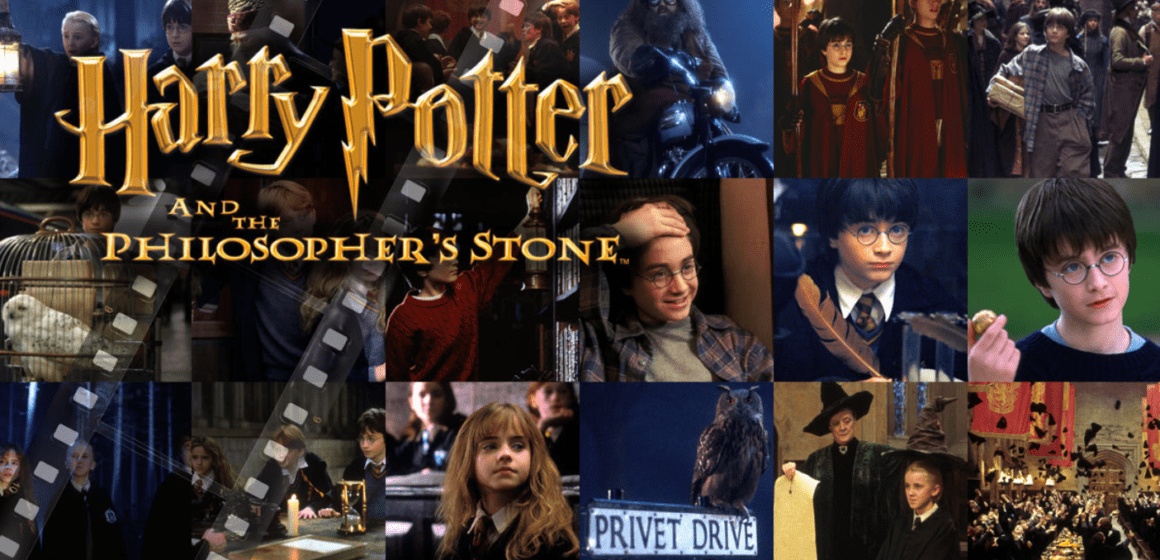
Leave a Reply